Author Archive: GenreChowderStudios
#30 Ou Mai
The highest ranking Ou child to wear a gold robe, 16 year-old Ou Mai has worked hard for her position. Her robe ensures her the power to pass minor tax laws, arrest anyone, go wherever she chooses, stand in for officials, and much more. Needless to say, Mai is a tireless worker who is in love with her duties. But far from being stuck up, she is very relaxed and personable. Â She is, however, strangely interested in wagons and wheelbarrows, and she has drawn quite a few of them.
#29 Ou Wao
An Ou male with hair? Surely, how could this exist? Ou males shave their heads when they begin to mature mentally and act like well-brought up children. Not to insult a child of the Ou family, but Prince Ou Wao is not very smart. There’s nothing mentally wrong with him, he’s just kind of unintelligent. Wao also says whats on his mind, prefers to play with his food rather than eat it, and can’t sit still for long. Despite being 10, when most Ou children being to straighten out, Wao is still unremarkable in his sophistication. Â His parent’s have not given up on him, however, because there is a glimmer of hope in him. Calligraphy takes patience, grace, and serenity to master, and at his very young age, Ou Wao already has calligraphy to rival that the most impressive scribe. Even if he didn’t have this impressive talent, he is still a very earnest and forgiving person, and unlike most Ou, he is not particularly arrogant, if at all.
#28 Ou No
One of the many Ou Children, Princess Ou No, 17, is one of the younger ones to achieve some degree of power. Gold and yellow colors are symbols of the Ou family’s power, and though she’s not wearing much, the Ao Liese can tell she has quiet a bit of power to dispose of. Being loud, opinionated, and arrogant like her brother Ou Ju, she has a reputation for abusing her ability to instantly have people thrown in jail. No also have the ability to make people do whatever she wants, but as No is not a people person, she’s never around enough people to abuse this power often. She does have a soft spot for paintings and sculptures, and when she’s not in the castle, she is looking at art around town.
#27 Yujote Kuma
Based on the old job of women sewing and buying clothes, a southern Nippon tradition is for women, on the 10th day on the 5th month, to give possible husbands a well-tailored and comfortable non-like kimono in an attempt to open contact between the two; the gesture is meant to say, “In a marriage between us, I will keep you comfortable.” The calligrapher Yujote Kuma had received a number of them every year on this day. On the 20th of the same month, men are supposed to deliver food to possible wives, preferably the one that sent them the kimono, as if to say, “In a marriage between us, you will not go hungry.” Kuma never responded to any of the advances on him, instead studying Harayin characters and perfecting his style. It is clear he wasn’t the culprit, but many, including his younger sisters, have died around him, causing his outlook to be bleak and melancholy. He was, however, sympathetic towards the deathly ill. Once, he traveled to a dying young girl’s home to keep her company during the last of her illness. She lived alone and was said not to pass on until Kuma stayed with her; when asked, Kuma would sadly say, “She couldn’t die alone.” It’s said that one of Huang Mu’s forms is based on the appearance of Yujote Kuma.
#26 Bao Zaeyon
In eastern Xiu Janyang Province, the number of delivery persons exceeds those of delivery personnel in the other two lands, and Bao Zaeyon is one of the Province’s massive workforce. Zaeyon delivers books to her area of the neighborhood. Even though she doesn’t make much money, she loves her job. Zaeyon grew up in a traditional Ao Liese household that taught her reading and history before she went to school to learn these things in detail. Now as an energetic young woman, she loves to read books about the Ao Liese nation and books that have strong traditional themes running through them. In fact, she’s not averse to sometimes reading the books she delivers.
#25 Shenyang Jun
Shenyang Jun is the son of the famous Shenyang Er. His father wrote one of Ao Lai’s bestselling books, Genha Shi Tuse, or Red White Blue when translated from Harayin, a story about a Nippon woman brought up on traditions who travels to America and meets an Americanized Nippon woman. Like his father before him, Shenyang Jun is a writer or good works, but unlike his father before him, he is not a lover of America. Jun is more reserved and uptight than his father, and he finds America too disorganized and violent. Despite being somewhat stuck up, he isn’t a stick in the mud; he does enjoy a laugh, and he is known for buying his wife very expensive gifts. His books are more on the side of the cautionary tale; he writes with much more palatable message than his father’s fish-out-of-water and character study stories. Acclaimed as a response to Genha Shi Tuse, Facaotsa Kin, or Golden Spring on the Mainland, was about a mainland Ao Liese woman whose life slowly fell apart due to her relationship with an American man.
#24 Moyura Tomoe
Moyura Tomoe, 12, has been an invaluble source of information of Ao Lai culture for American reporters. Between practice sessions and daily chores, she gives us information about the day-to-day lives of her people and her fellow workers as well as an insight into Ao Lai’s history. Americans are welcome in Ao Lai, but it’s almost a de facto rule in Ao Lai that the Ao Liese do not leave their soil; prices to travel to America are in the top five of the most expensive things an Ao Liese person can buy. Because of this, Tomoe has not been to the states, but she was curious about the Americans, as many Ao Liese are, and did not turn down the oppurtunity to speak with us when we offered her a special spot on our radio show, Purple Country, a television program in which guests, both Ao Liese and American, explore a topic and how its impact differs between their cultures. Tomoe was an innocent and curious but very mature girl, and her apperance was a hit in America and even more so in Ao Lai, where the show is brodcasted as a podcast. When fans clamored to see more of Tomoe, we offered her another chance when we asked her for an interview. The response was as expected, and soon, Purple Country and Ms. Moyura began to slowly, very slowly, bridge the gap between America and Ao Lai. We asked her about the nature of her work and one of the uniforms she had, and she told us:
“The Mensenjaji… of Ao Lai’s Nippon are the women and girls in the art called Mensenyokaji, the female profession of communing with Ao Liese spirits. Ao Liese people believe women are more in tune with the spirit world because we are healthy and feel many more emotions than men. They are in touch with the mytical creatures. Mensenmu is my rank. I perform the ceremonial dances that are accompanied by music or by singing or both. My makeup… is meant to symbolize or represent the face of the spirit of… merciful death, Huang Mu… The red paint enhances the features and imitates the folds on Huang Mu’s face. The blue makeup highlight/imitate the loss or stagnation of blood in certain areas. The whitish makeup… represents the pallid complexion of those that are ill, dying, or dead. My outfit is not a furisode. It is called a “non,” which is Harayin for “long.” My sleeves are very long, because I have items I use in my dances in my sleeves. I need room to pull them out gracefully. The colors are the ones… the Mighty Huang Mu… is often seen wearing, so… I wear that. The flowers and leaves in my hair mostly represent beauty… I wear 12 pins in my hair, because 12 is a symbol of womanhood, and Huang Mu… prefers to interact with woman instead of with girls.”
#23 E’so
Though having the body of a ghost, Akio Sogomo is the spirit of death by birth. She owns a small portion of Otherworld devoted to the dead, and she rarely leaves her designated area except to escort those who die in childbirth to her realm. She has a king-subject relationship with Huang Mu. Quiet and often with a bedside manner, she is strangely said to be cold to child spirits. In northern Nippon, Ao Lai, it is tradition to gift a family whose lost a woman to childbirth with a small image of Sogomo.
#22 E’tu
Wongno Tuyong is not a deceased human. He is the spirit of year-old death and death after that. Tuyong, like the spirit Huang Mu, is one of the few spirits who prefer to be in the presence of women as opposed to men. Taking the form of a ghost himself, Tuyong is assumed to have a casually friendly relationship with Huang Mu. The container is believed to be a bottomless pit of the remains of all dead Ao Liese people. Tuyong never leaves the container out of his sight, and he is almost always holding it.
#21 E’bi
Yamamoto Bikomi loved trees, and most of all, she loved the cherry tree. Her and her family went to see the first blossoming of the cherry trees every spring. There’s a saying in southern Nippon, Ao Lai: “Girls who collect cherry blossoms are more beautiful.” The cherry blossom is a symbol of traditional Nippon, and the thought behind the saying is that girls who subscribe to traditional Nippon values are more beautiful than those that don’t. Most girls understand that, but Bikomi, who always lacking a sense of subtlety, took the saying literally. She was last seen wandering off into a midst of the spring’s radiant cherry trees. No one is really sure how she died; perhaps she got lost. Some have said that they’ve seen her ghost still wandering amongst the trees, sadly holding a delicate cherry blossom petal.
#20 E’ke
Waru Kegoku was said to be an amiable enough man while sober, but as a drunk, they said he was a silly and sloppy person. He owned an inn that served a fragrant brand of rice wine called I’sake’i, simply “sweet, sweet wine” when translated from Harayin, that is still popular and sold in southern Nippon today. Kegoku would often drink with the customers deep into the night and was said to have gotten in trouble for many different reason relating to this habit. His last time ended in a drunken brawl that somehow killed both involved. Waru Kegoku’s ghost is said to still be in his old inn, drinking, enjoying himself, and savoring the taste of his wine as he did in life.
#19 E’na
During the last years of her short lifetime, Xiu Janyang resident Chun-Yu Naminbak was a writer of short poems. But far from being a full-time poet, Naminbak also wrote secret reports on the often unethical doings of the emperor’s men (his soldiers). She was a great believer in justice and fair treatment of the Ou’s subjects. Â She began writing when she was around 17 and disguised some of her less inflammatory works as poems condemning her own ideas. She passed out her other works to villagers in Papuromura, and according to history, her writings reached at least a town or two away from hers. Strangely, she married a court official, but all evidence suggests she did that for cover and to be closer to the subject she wrote about. More than once, she was accused of peddling anti-government material, but she hid scraps of her work in a long pink cloth which she claimed held her underclothes, which was partially true because it wasn’t uncommon for her to write snippets of her work on her underclothes. Â Her oblivious husband was a proud man and refused to allow his subordinates to search through his wife’s underclothes. As Ao Lai is not a nation of free speech, almost as soon as she was discovered passing her works out in another town, she was jailed and soon put to death. She was said to handle her incarceration bravely, never relinquishing her beliefs, and die with her dignity intact. Naminbak was said to be a very prolific writer; her works are said to not be entirely accounted for, and they’ve found over 200 individual works. She’s said to be haunting the Papuromura main police office, decrying the practices still common today.
#18 E’si
Musician Hukutegawa Siten, blind as a man in night’s darkness, was said to be one of the kindest and calmest people in Kinogomura, Nippon. Also said to be quiet good-looking, Siten lived in a one-room hut and gave shelter to those that needed to escape the heavy rains common to the land. One day, he let in a group of women that, unbeknownst to him, was actually a traveling music troupe. He played the shamisen for them while the rain delayed their travels, and they were so impressed with his skills, they insisted he come with them. They brought him to their hometown, Daidaomura, in northern Nippon, and helped him start a career as a professional musician. He happily played in inns and Xixumasa group home for years, charging low costs yet making a great deal because of his talent and kindness. He returned to Daidaomura one day to thank the traveling women only to find that, by order of Empress Ou Mefang, they’d been forced to disband and exiled for distracting workers from their daily scheduled duties. He was never able to find them. Siten later was exiled for the same reason and was made to return to his shack.  He held a seething rage about this unfair treatment to his natural death many years later. Now people say that he can be seen wandering the streets of many different towns and cities, looking for those that gave him his musical career.
#17 E’zu
Lumeng Zumei did not have a happy life. Frail and ill as a child, she rarely left her home, and when she did, she faced discrimination. With their men strong, wealthy, and just, and their women beautiful, fertile, and wise, the Lumeng were known for being a fast-growing family of great status. Zumei was a disgrace in the eyes of the Ao Liese community even though the family itself did not treat her as an untouchable. Zumei herself hated bringing shame to her family name. Gloomy and self-loathing, she was known for having a love-hate “relationship” with the red swan emblem of the Lumeng. The symbol stood for strength and grace, two things Zumei never had. When she was 17, the heads of the family arranged a marriage for her, but she was only just barely strong enough to move into her new husband’s home when she was 19. Despite her chronic depression, Zumei and her new husband grew to love each other quickly, and it would seem that she would have some happiness in life after all. The blow would come when the couple realized that she was more than just too weak to have a child, she was barren. The sadness was too much for Zumei, and she commited suicide. She’s now said to visit orphanages and watch the children, trying to pick out one that looks enough like her and her husband so she may claim a child and prove she was not a waste of a woman.
#16 E’oo
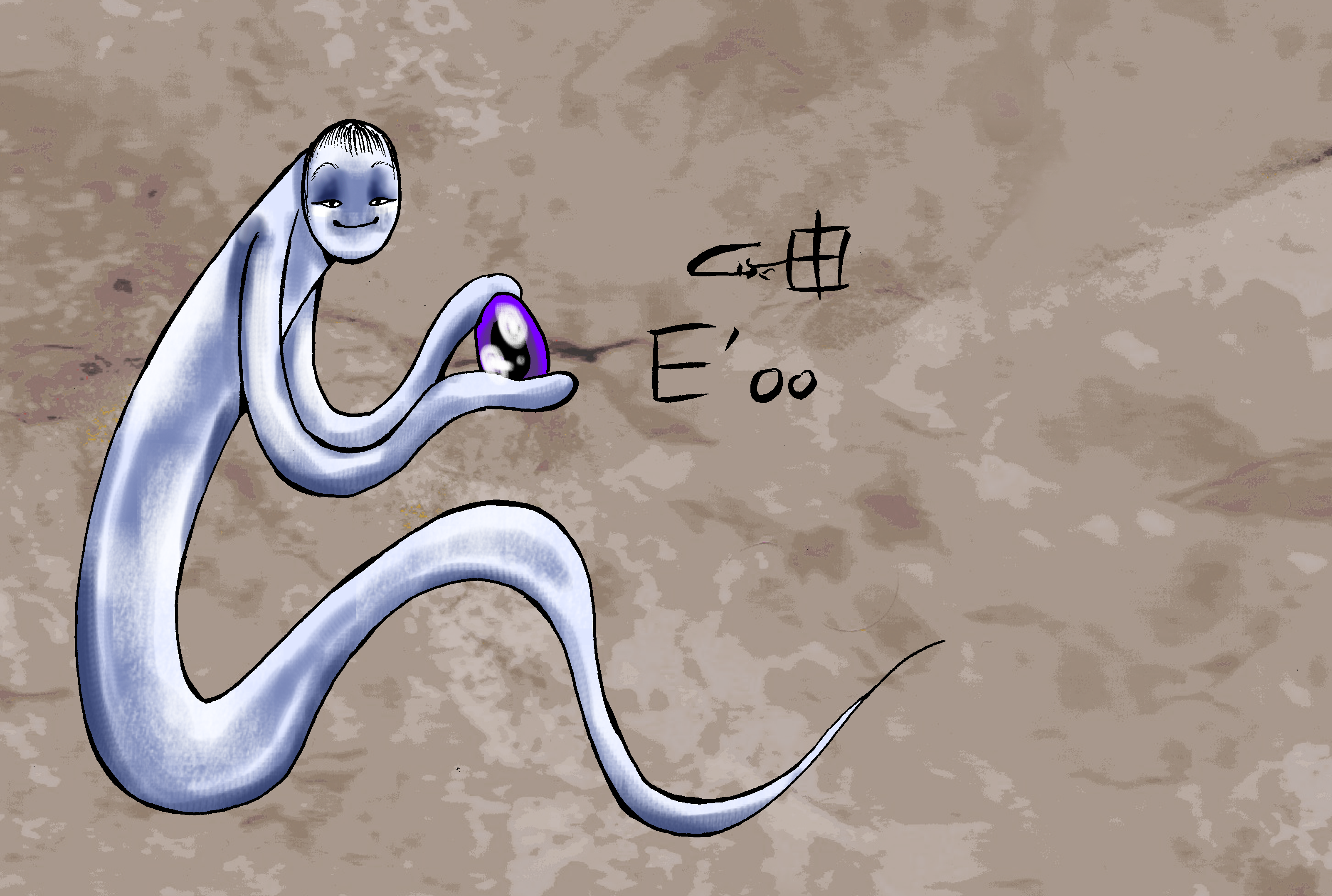 E’oo holding the Eye of Ao Lai
E’oo holding the Eye of Ao Lai
In life, Chion Oowing was a treasure hunter, and a clever one. He was not always in it for the money: he loved to record the historical artifacts and study their aethetic beauty. A famous collection of treasures in Ao Lai consists of the many artifacts buried by Ao Lai and her allies, and the one that held his interest was what native Ao Liese call the Eye of Ao Lai for its vivid violet hue. As with many treasures, he was not the only one after it. Others tried to capture this treasure and sell it; during Oowing’s time, the jewel had only been buried for a few decades, and it hadn’t yet gained the status of national treasure. Oowing wanted to find it first to ensure its protection. He did manage to outwit the others many a time. The race for the Eye of Ao Lai was long and brutal, and in the end, Chion Oowing was killed by the opposing hunters. However, thanks to his ingenuity, he had safely hidden the Eye where still no one has found it. They say he can be seen wandering the sites where he tricked his opponents about the location of the Eye of Ao Lai. Every place he’s been seen, there has been extensive mining in order to find the Eye. No one has found it so far.
#15 E’mo
While she lived, historian Takeha Motoko of Nippon who studied the elusive mountain people, the Gakano, or Gakuno as mountain dwellers call them. She was very artistic and creative; she loved to carve and paint, and she created masks based on the faces of the Gakano people she met. She became very close to them and even considered moving into the dark caverns the Gakano spent their entire lives in. Unfortunately, the Takeha clan, a loyalty-based and solitary people, saw this as Motoko abandoning their clan, and they threatened her with extreme punishment if she continued to become close to the Gakano. She refused to give up her life’s work and fled to Masayama, or the City of Mountains. Within the year, Takeha Motoko was found and killed by hired Takeha assassins. Now she’s said to roam the summit of Masayama; eyewitnesses say they’ve seen her with various masks of Gakano faces.
#14 E’ji
As a man from the Xiu Janyang Province, the late Soo Jiyung was a reserved, opinionated but well-meaning scholar of Ao Lai history. People rarely saw him, but when they did, they described him as slightly cold even though he was intelligent and wise. He even had a wife who said Jiyung may have barely loved her more than his work. Shortly before his demise, Jiyung was said to have stated that he was at a historical breakthrough in his research. In one of the most mysterious and shady murder cases in Ao Lai history, Soo Jiyung’s charred remains were found in a ceramic bottle not a week after that. To this day, no one has found the murderer(s), a provable motive, or even the scene of the crime, though speculation dictates that he was about to uncover something in Ao Lai history someone didn’t brought to public knowledge. Even so, many agree that he haunts the Nation’s Library of Ao Lai, floating amongst the aisles of books, saying, “It’s a lie. It’s a lie.”
#13 E’ma
Jiang Maqiaodi was a beauty of from the mainland central of Ao Lai. In life, she was a skilled calligrapher and connoisseur of fine paintings. She was said to be intelligent and witty. Maqiaodi had a sharp tongue, according to those reports from those that knew her, but apparently she also kept to herself. The Ao Liese language, Harayin, has hundreds and hundreds of characters, and she strove to learn as many of them as possible. The sad fact of the matter is that she died suddenly due to an unknown yet powerful illness. Now they say you can see her haunting places of knowledge. Her favorite is the Nation’s Library of Ao Lai, where she may be seen reading books of Harayin or examining the many woodblock art on display there.
#12 E’ku
Banda Kura was once a well-off merchant, one of the few that traveled between only a few towns. While he did not sell grand things, he was a smart yet honest businessman who cared for his customers and provided dependable products. While traveling alone, E’ku was ambushed during his rounds. Sadly, he didn’t survive. However, his ghostly spirit is said to travel along the route he used to walk while alive. Eyewitnesses say he holds a bag, the content of which is debated. Is it the goods he last carried, his own remains? On an interesting note, his route went between the Nippon towns Niwengmura and Reihu’a’mura, and each town has its different idea of what’s in his bag.
#11 E’me
Born into the Ao Lai-ruling Ou family, Ou Mefang was one of the first Ou to be born in Nippon and rule there. Her yellow accessories and gold tinge are evidence of her royal birth, and her very brown hair, while common amongst Ao Liese, is said to be only found in ghosts of the Ou family. She was said to be a sweet and quiet woman in person but a strict and rather unforgiving ruler. However, in her earlier years as ruler, she was kinder. Mefang hated idle behavior and distractions; during her more peaceful years, she was a large advocate for strong work ethics. Her policies led to the ban of radios in the Nippon workplace. Seven years into her rule, Ao Lai mainlanders revolted against their feudal lords and set fire to a half dozen mainland settlements. She became something of a tyrant in order to scare her subjects into obedience. This did not work as well as she wanted; before her death, she was the victim of three know assassination attempts. The second attempt on her life was said to cause Mefang to have a near-death experience. Ghosts who have had near-death experiences are said by Ao Liese to have bells attached to their person once they actually do die. The fourth assassination attempt on Ou Mefang was successful, and now she is said to haunt her old castle during the Month of the Dead.
#10 E’jo
Before her untimely demise, the renamed ghost E’jo was a prolific member of the Hikoto clan named Johime. Her royal status can be inferred from her gold-ish hue. She was one of the many Hikoto who traveled to the central mountains of Nippon to see the breathtaking ranges and surmise its livability for royal class. The Hikoto were a distant cousin to the Ao Lai-stationed Ou family and ruled with similar power in Nippon before they were overthrown. The beginning of their downfall began when the people of the northern islands fought the Hikoto for the same land. Johime was assassinated by an inside man, Nogada Shu; he killed her by choking her with the blue handcloth she gifted him. Now it has been said that her ghost torments the Nogada family. Eyewitnesses and victims say that she attempts to smother Nogada people with the same blue cloth that killed her.
#9 E’wa
Once named Negishite Watanabe, this mouthless ghost died due to execution. He spoke too much all his life, and finally, he mouthed off to the wrong person. He can now be seen haunting his site of demise by Nippon city Yamamasa. The official who killed him was said to have fled to Xiu Janyang Province to escape Wanatabe’s tormenting.
#8 E’yo
Ihe Yoshang was an Ao Lai Mainlander who traveled to Nihon and died of starvation there. He was too poor to help himself. He can sometimes be see floating around town, holding a bowl of water.
#7 E’nu
Moyama Nuko was once a shy and beautiful town girl who loved the view of Xiaimasa from the hills. Unfortunately, one day, she was peering at her beloved city when the rains were too much for her. The rain made her ill, and she passed away. People who see her spirit say she now travels everywhere with a parasol to keep from getting wet.
#6 Tsumasu Ryukon
He’s never been to a formal school, but to everyone’s surprise, Tsumasu Ryukon is very much an intellectual. He’s studied the Ao Liese spirits as well as Harayin, the language of Ao Lai. He travels via super cow-pulled wagon, sharing knowledge. He wants to be married, though, so he’s looking for a wife.
#5 Dato Go
A boy living on the streets, Dato Go has learned his way around Xixumasa, or “Water City.” It’s toughened him a bit, but also made him ultra curious and too excited at the thought of exploration. He’s been on many already, and even though he can look frail, he’s a very fast runner.
#4 Ou Na-Ting
The wife of the reigning Ao Lai emperor, Ou Na-Ting. As her status, dictates, she has the power to suggest and pass royal decrees across the land. Being the mother of Ao Lai’s next rulers and being of royal blood, many of the land’s laws don’t affect her. Her presence means a great deal, though not as much as the emperor’s, and misconduct with her is severely punished. Most notable, however, is her power to influence the emperor.
Ou Na-Ting herself is a peaceful and soft woman. “Her words are whispers but leave impressions greater than the most talented poets of the land,” the emperor says. She is said to be the sweetest willow in Ao Lai; none that meet her can can criticize her gentle kindness. Some have said, though, that the infamous Ou Ju got his incredible forwardness from his mother.
#3 Kaetung Sun
Kaetung Sun has lived with his younger sister ever since their parents passed away. He is known to be one of many poor orphaned children in central Xiu Janyang and is mostly overlooked. As Sun only has fruits to sell during the harvest, he only makes crop money once a year. Year round, he does carpentry work, which helps somewhat.
#2 Kohi Chippu
From the Mountain of Fruits and Flowers, Kohi Chippu is a valued scout of the monkey kingdom. Traveling from the coldest tip of northern Nippon to the sultry jungles of southern Xiu Janyang Province, she gathers information about the land. She then returns to the Mountain and reports to the reigning king.
#1 Prince Ou Si
A younger brother of often seen Prince Ou Ju, Prince Ou Si has a sulking yet proactive disposition. Unlike Ju, he prefers the quiet and solitude of the castle’s book chambers. He’s also more intelligent than many of his siblings, older or younger, but maybe not as wise.
Every morning at 5 am, the castle’s ceremonial bell tolls to signify the start of the workday. Si, despising loud noises, has a history of removing the bell from the hooks it hangs on.
Even though he’s of similar age to Ou Ju, he doesn’t wear yellow, a symbol of royal power, because he’s not mature enough; only those with actual monarchial powers wear yellow. Instead, he wears a warm gold color, simply a symbol of royalty, whereas Ou Ju is allowed to wear yellow.



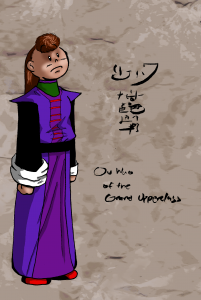
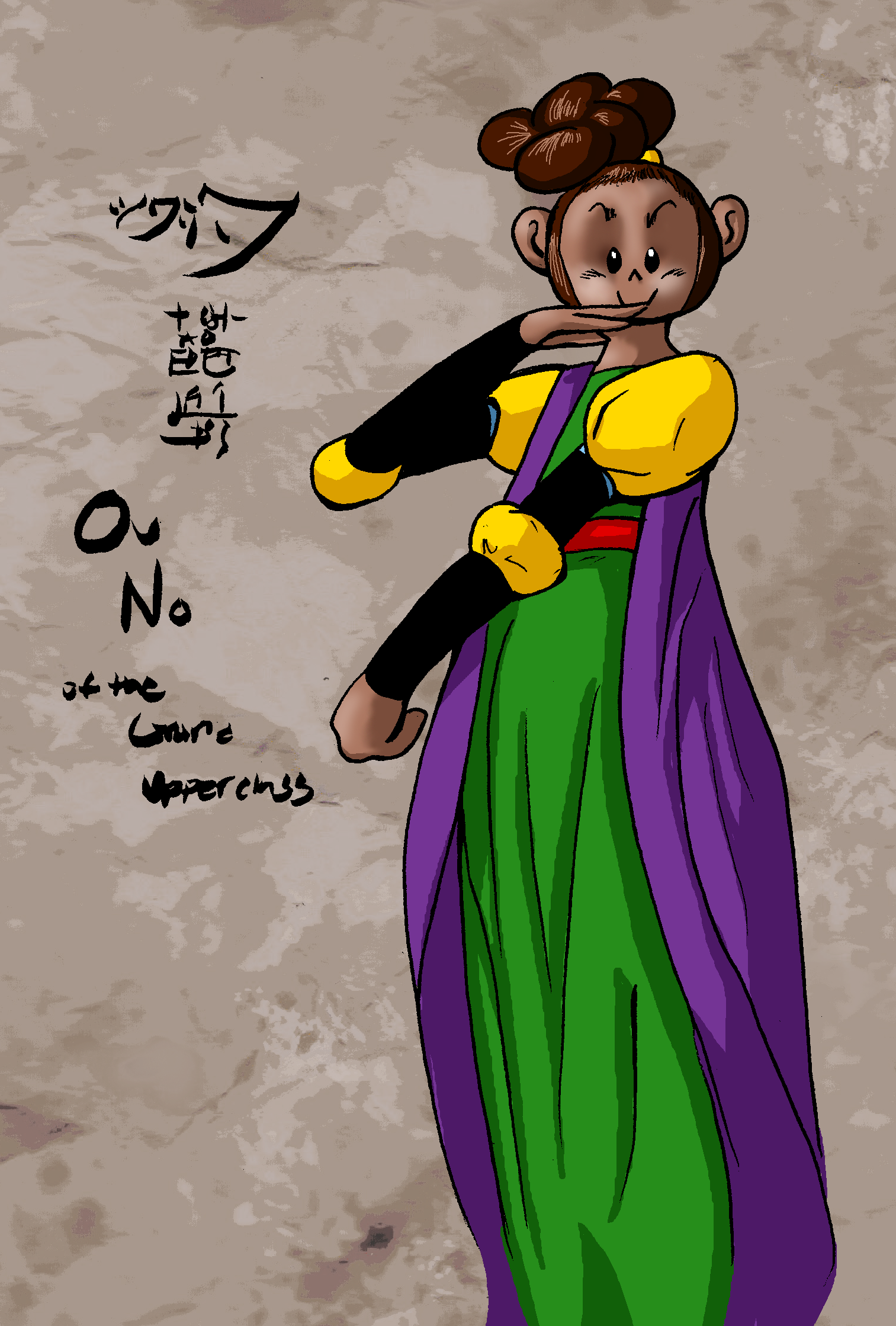
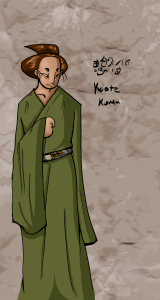
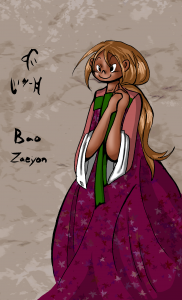

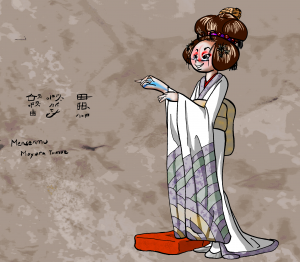

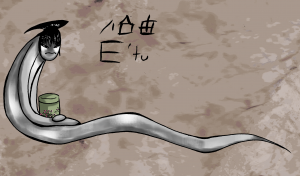
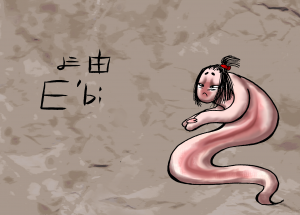
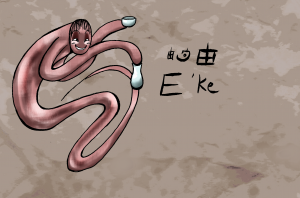
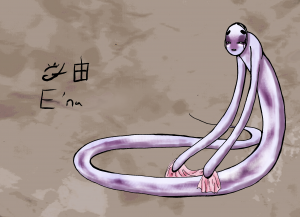
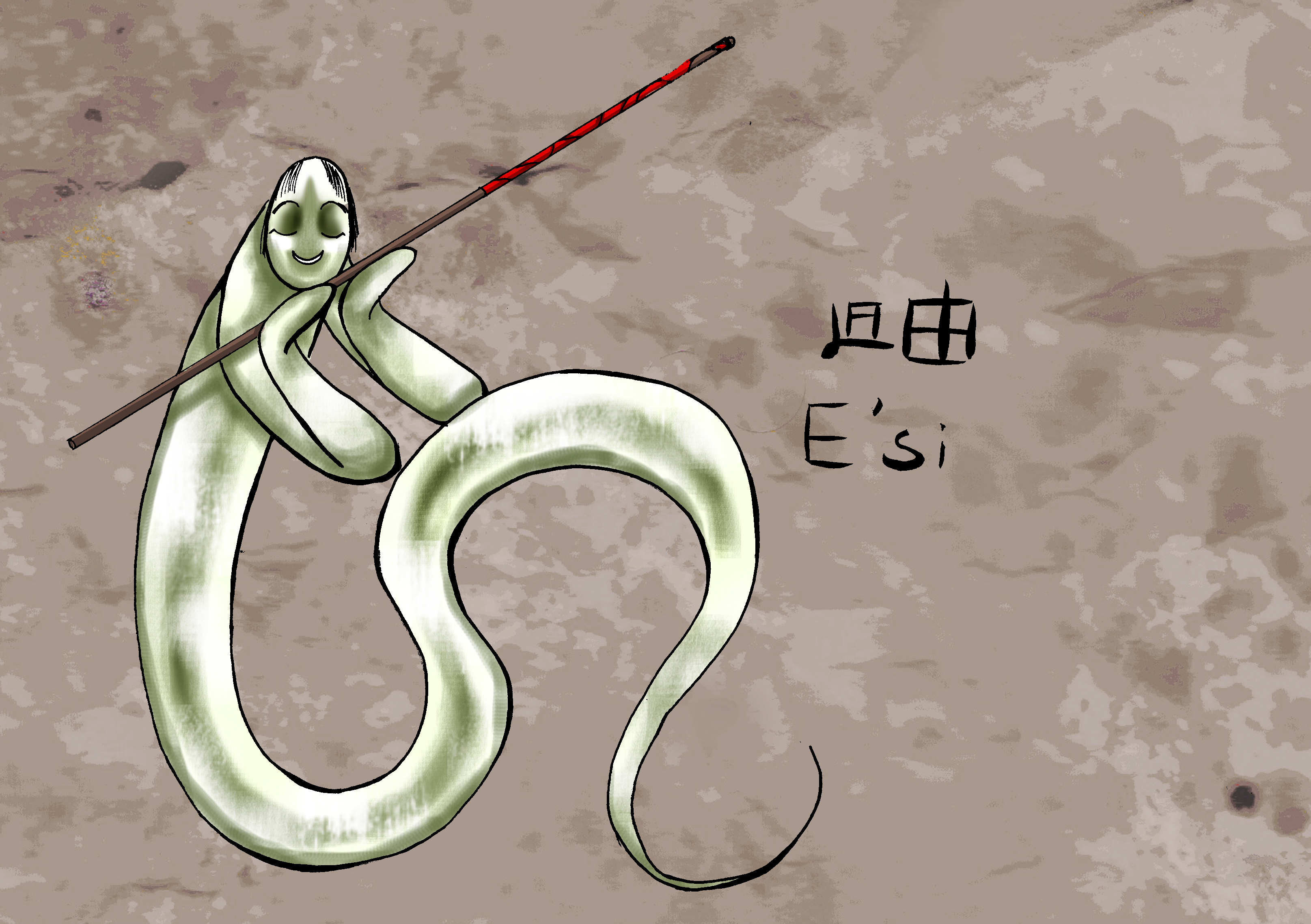
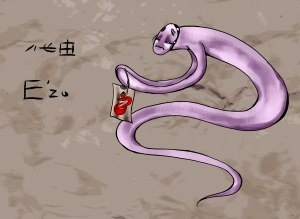
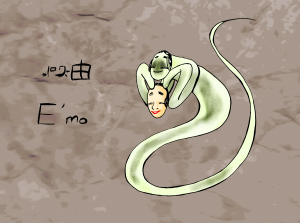
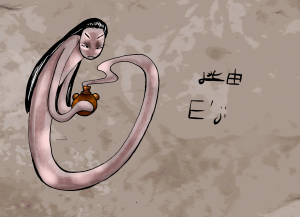
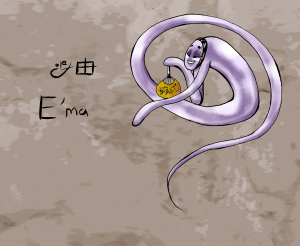
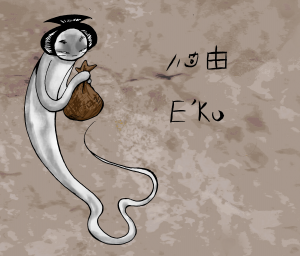
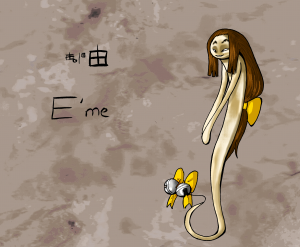
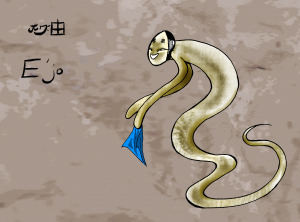
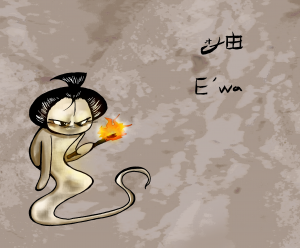
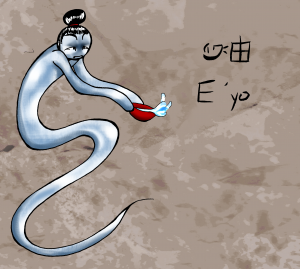
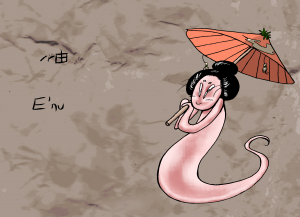
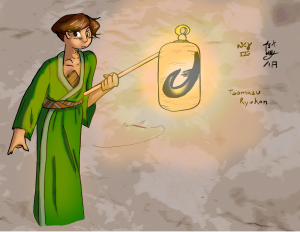
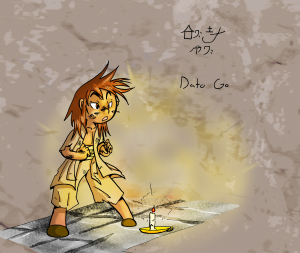

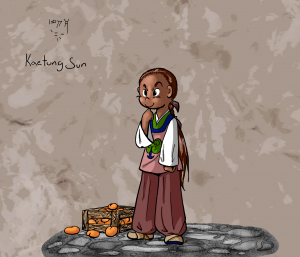
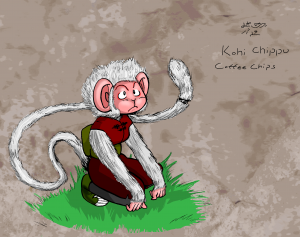
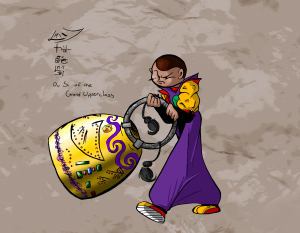








#30Characters Chatter…